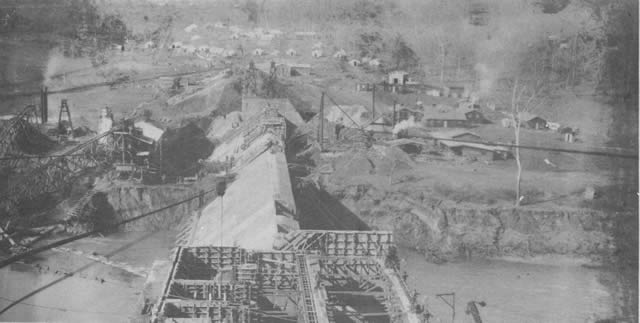Volume 1, Number 7 - Spring 1963
Camp Ozark
Since transportation was still slow and difficult in Taney County during the time Powersite Dam was being built, most of the workers lived at the dam site. A great many of them had their families with them, and at one time the population of the camp was about 1,000 people.
In November 1911, two bunkhouses had been completed, as had the store, dining room, and kitchen. Cottages for company personnel were being built, and by December sixteen had been finished. They were assigned to Messrs. Gallagher, Green, Caley, Authier, and other employees of the company. A Mr. Allen was in charge of the commissary.
Writing about Christmas 1911 at the camp, the Taney County Republican reported, "Christmas night the inhabitants of Camp Ozark, as they call the new city, planned to give a dance in the new dining hall. Several of the town people had been invited to attend and a number of them had made preparation to go, but the rain came and most of them backed out. We understand that those who did go were well repaid for the trip and had a very enjoyable time dancing, with good music, and other forms of entertainment for those who did not wish to dance."
During 1912 and into 1913, Mr. B. A. Parnell, Sr., now a prominent retired banker and businessman of Branson, was in charge of the commissary at Camp Ozark. The commissary, supplied from Bran son, stocked drygoods, groceries, and all items found in a general store at that time. It was in a building of twenty by thirty feet, having also a wareroom.
When asked about recreation at the camp, Mr. Parnell said, "You made your own." He went on to describe the camp as being located above the dam about 200-300 yards, made up mostly of bunkhouses and tents, and being a "fairly orderly" place.
Near the west end of the dam was a log cabin remembered by Mr. C. H. Holman as one of the best he had ever seen. Mr. Holman, an engineering graduate of Washington University, was in charge of surveys made for the promoters of the dam. He had been living in a tent for several months, and when he moved to Camp Ozark early in 1912, 'the log cabin, whitewashed inside, was a welcome change. "It was right by a spring," Mr. Holman recalls, "and had been the home of the Oliver family. They had homesteaded that piece of land before the Civil War. Jess Oliver told me about it one night when he was going by and stayed to have supper with us. He said that he was born in this house, and his father had been born there also, about seventy-five years before."
There were about forty school-age children among

Camp Ozark during construction of Powersite Dam
[11]
the families of the workers . The construction company built a school and hired a teacher for them.
Sanitary conditions were described as good and there were no serious outbreaks of illness. The water supply, according to the Forsyth newspaper, was carefully guarded at all times and the company did everything possible to carry out the directions of the state board of health when they were asked for an opinion on the best method of warding off disease.
After fifty years, the water supply is still remembered by Mrs. O. A. Blankinship: "It was highly medicated, but at least it was water and evidently safe for health". In 1912 she was a young house wife living at Camp Ozark, and her husband, James Cummings, was employed as a surveyor. "After the surveying was over," she writes, "we moved from Forsyth to the Dam-first to a couple of tents half a mile above the dam. I suppose the housing there wasn't ready; later we moved down to Camp Ozark to company housing. It was of one-wall construction, but there was ample room for our family. The company employed a man to carry all of us four buckets of water a day from the spring."
Nearer to the river than some of the other houses was a bunkhouse used by the Italian workers. When the first flood waters came rushing over the dam, the bunkhouse was washed downstream. By this time, the work on the dam was nearly completed, and instead of rebuilding, the workers moved to tents.
Camp Ozark faded from existence, but its permanent buildings are now part of Ozark Beach, one of the many early developments on the new Lake Taneycomo. An imposing hotel, now the Lakeview Rest Home, was built by the Crist brothers. A post office was established August 7, 1919, with Verdon K. Darby as postmaster. Succeeding Mr. Darby In the post office were Harvey J. Lewis, Myrtle E. Williamson, and Mrs. Roy Burns.
Acknowledgements: Our thanks to Mr. W. E. Freeland, Forsyth, for permission to use his files, and especially the July 10, 1913, issue of the Taney County Republican which told the story of the building of Powersite Dam in articles by F. F. Baily, and R. T. Bailey. Photographs 'were generously loaned by Juanita Franklin, Ozark Beach, and Dr. L. S. Shumate, Reeds Spring. We appreciate receiving the photographs furnished by Mr. Art Kane of the Empire District Electric Company, Joplin, for use in this issue and for the Society's files. Mr. C. H. Holman, Branson, having been the engineer in charge of surveying, provided valuable information on the building of the dam. We also thank Mrs. O. A. Blankinship, Honolulu, and Mr. B. A. Parnell, Sr., Branson, for their help in answering questions about the dam and Camp Ozark.
[30]
This volume: Next Article | Table of Contents | Other Issues
Other Volumes | Keyword Search | White River Valley Quarterly Home | Local History Home
Copyright © White River Valley Historical Quarterly

